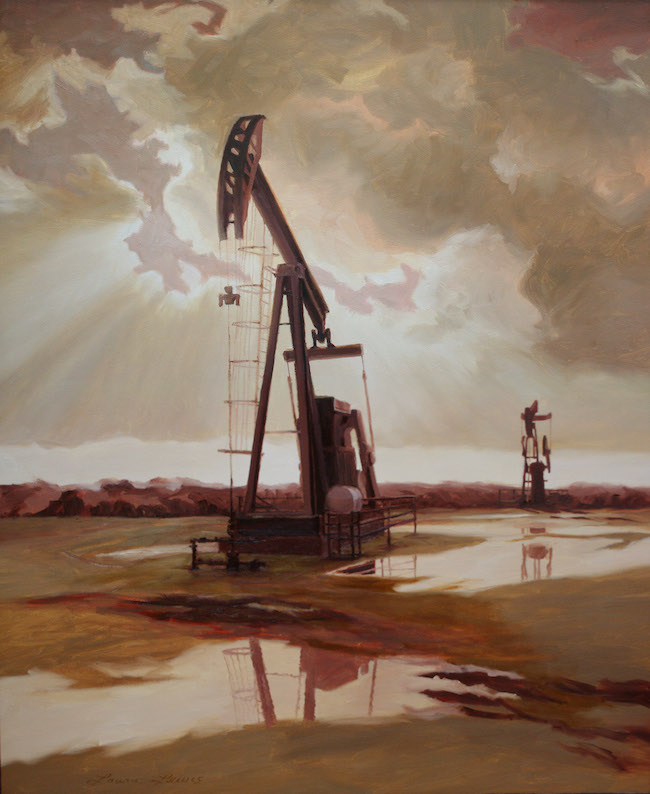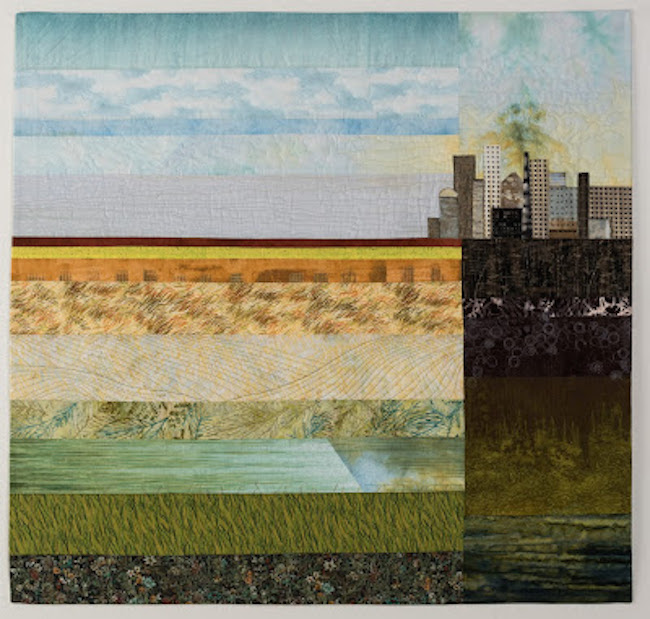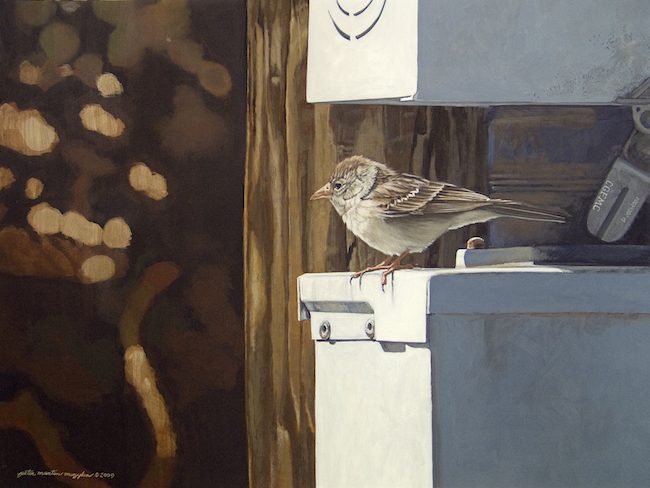I recently helped Rob, my husband, with a presentation he was preparing on the topic of virtual reality.
Now, he’s a smart guy. He has a Ph.D. in mathematical physics, so he wasn’t asking me what I thought about his virtual reality angle. He had that covered.
He was seeking tips on how to take what he knew and massage it into a better presentation.
Here’s some advice I gave him, which might serve you.

Make It Visual
Bullet points are okay when your audience needs to write something down and remember it later. Otherwise, opt for visuals.
I use images as much as possible, but sometimes I make fun graphics out of words – sticking to my branding, of course.
You’re lucky! You so have this because your topic is inherently visual.
Most artists need only slides of their art for presentations, but sometimes you want to include in-process and in-studio photos. Anything that reveals what goes on behind the scenes is a winning addition to your presentation.
Any images you use for your presentation can be repurposed. You can use the same images for your blog, newsletter, website, and social media accounts.
Time It
Rob had just 10 minutes for his presentation.
Ten minutes! That’s how long it takes for someone to introduce an academic delivering a paper. The organizers of the event clearly understood that attention spans are limited to non-existent these days, so why speak longer than people are inclined to sit?
I encouraged him to practice a lot and time it so that he could easily fit what he had to say in the allotted 10 minutes.
People will like you more if you end on time, I advised. Better to leave them wanting more than to wonder why you’re still on stage.

Focus
What is the most important thing your audience should know about your topic?
Free write about the most important aspect of your talk.
Free writing involves setting a timer for a specific period of time (ex: 15 minutes) and letting your pen flow freely across the paper without lifting it. Just keep writing until the timer buzzes.
Adapt your topic using the following examples.
Painting outdoors is cool because …
You should have your portrait painted because …
This is how carving is different than modeling …
You should be interested in my project because …
Just keep writing and collecting words. You won’t use everything you write, but you’ll have the phrasing in your back pocket.

Whenever you find yourself using language like “this is really cool” or “it’s unique,” take time to flesh out the meaning with the free-writing exercise. You may know why it’s cool or unique, but you shouldn’t presume that your audience is on that same wavelength.
By the way, this also applies to vague language in your artist statement. Flesh it out.
After collecting a page or two of words during this process, return to your presentation.
- Add anything that you feel is missing.
- Remove whatever is unnecessary or doesn’t support your key ideas.
What do you want your audience to do when you’re done?
Rob wanted his audience to try something out, which is a pretty easy sell, but he wanted to remember to encourage this action.
You might want people to:
- Look at your art.
- Sign up for more information.
- Register for a program.
- Give you feedback about something.
Whatever it is, invite them! But before you do that, make sure you have set your talk up so that they are prepared for the invitation and can’t refuse. Don’t assume they know the next step.
Get the words down! Enroll in our Magnetic You on-demand class now and be ready for these opportunities.



14 thoughts on “Presentation Tips for Your Art Talk”
Thanks Allyson
These are great tips and I certainly use free writing when it comes to the first draft for my books, but I hadn’t really thought to use the same technique in preparing my talks. I was working on an outline for a July talk and now I am going to go back to my free form way and see what comes up.
Make narrative! My other half put this to me having watched one of my early talks.. Even the shortest presentation needs a narrative drive – he suggested (and I do) 5 sections – I do Trunk Shows which are different avery time, but my 5 might be
Beginnings
Progress
Oddities
Series
Art
Yours will vary.. I pack the suitcase according to the audience I anticipate, in reverse order of course, then busk the talk.. Sometimes you get a blank expression in the first couple of minutes and need to backtrack a little..
Oh, and if they laugh, at or with you, they will be Happy
HH
Thanks Helen and Alyson
This would also be good information for youtube videos
Dennis
Great tips! I just have one thing to add. Make it interactive! If you don’t have time for the audience to share their experiences or to ask questions, then ask them to raise their hand if they agree with something or find some other way to get them involved.
Interactive presentations are really great when you’ve been told to make it longer rather than shorter. Be sure to give the audience time to work up their courage to actually participate. As Laurie suggests even a reaction such as raising of hands (or shout itvout) can make the presentation memorable.
Also, make eye contact. This helps make a connection between speaker and audience.
People love to hear stories and they engage more in the presentation. If the people have been sitting through a series of talks, have them stand up for your 10 minute presentation.
Inject humor whenever possible. When you as a speaker hear your audience laugh , it relaxes you and, of course, everyone likes to laugh and will warm up to you and pay more attention.
This article made me really think about what people would really interested in knowing about me and my style, and mostly what I want them to walk away with. Nice article!
I am a metal artist, and I brought in samples of my work and passed them around as I talked about my process for designing and creating them. That really helped them visualize much more since most of them were not familiar with this process and they could touch the art!
Perfect timing, Alyson,
Recently, at a conference, I heard seven authors tell their life stories, and by the last one, vowed NEVER to tell MY life story at a talk– unless asked!
That experience and your article have made me look at an upcoming presentation with new eyes and ears, pushing myself to use more visuals that share with the audience what inspires my work and my passion.
Your articles are always spot on!
I have given about half dozen talks. This info helps flesh out better ways. Laughter and smiling are important. Looking around to all the eyes, getting them involved, knowing how to tell a brief story. Once I kept asking if they wanted more and it ended up going longer than expected so one must be ready with more than 10 minutes planned.
Once at a contemporary masters museum exhibition , I was asked to speak ” you are on in 3 minutes”… YIKES it was all patrons and sponsors. Be prepared!
Thanks for the great article. I recently did a TEDx Birmingham talk and your advice is in line with the suggestions from them. I enjoyed the process of preparing my talk and one of the best pointers was to focus your talk on one idea. When you are very passionate about the subject that is hard to do. I started writing it in Oct, 2015, and the conference was in March 2016. The shorter time limit is a great idea too. My talk is nine minutes and that is plenty if you are focused. Even though I will probably never do another TED talk, the things I learned doing this one will help me with any other talks. Thanks for all you wonderful articles! https://youtu.be/YB3iKkarDJY
Actions to get people started talking/asking questions — When you ask for questions or comments, at the same time raise your hand as if you were in the audience. Sometimes that will miraculously cause someone to raise their hand to be the first to ask/comment. If nothing happens, be ready with “I’m often asked ….”, then, after answering your own questions, ask for the “next question.” It usually works, but it doesn’t hurt to have, at the ready, a question to ask the audience, i.e, “Does (or has) anyone ever … (whatever fits the situation)?
I think incorporating visual elements to your presentation really helps engage audiences. It’s important not to blanket these with paragraphs of text, so I would definitely keep it simple if you do decide to include text in your PowerPoint or slide show. Thanks for sharing the tips!